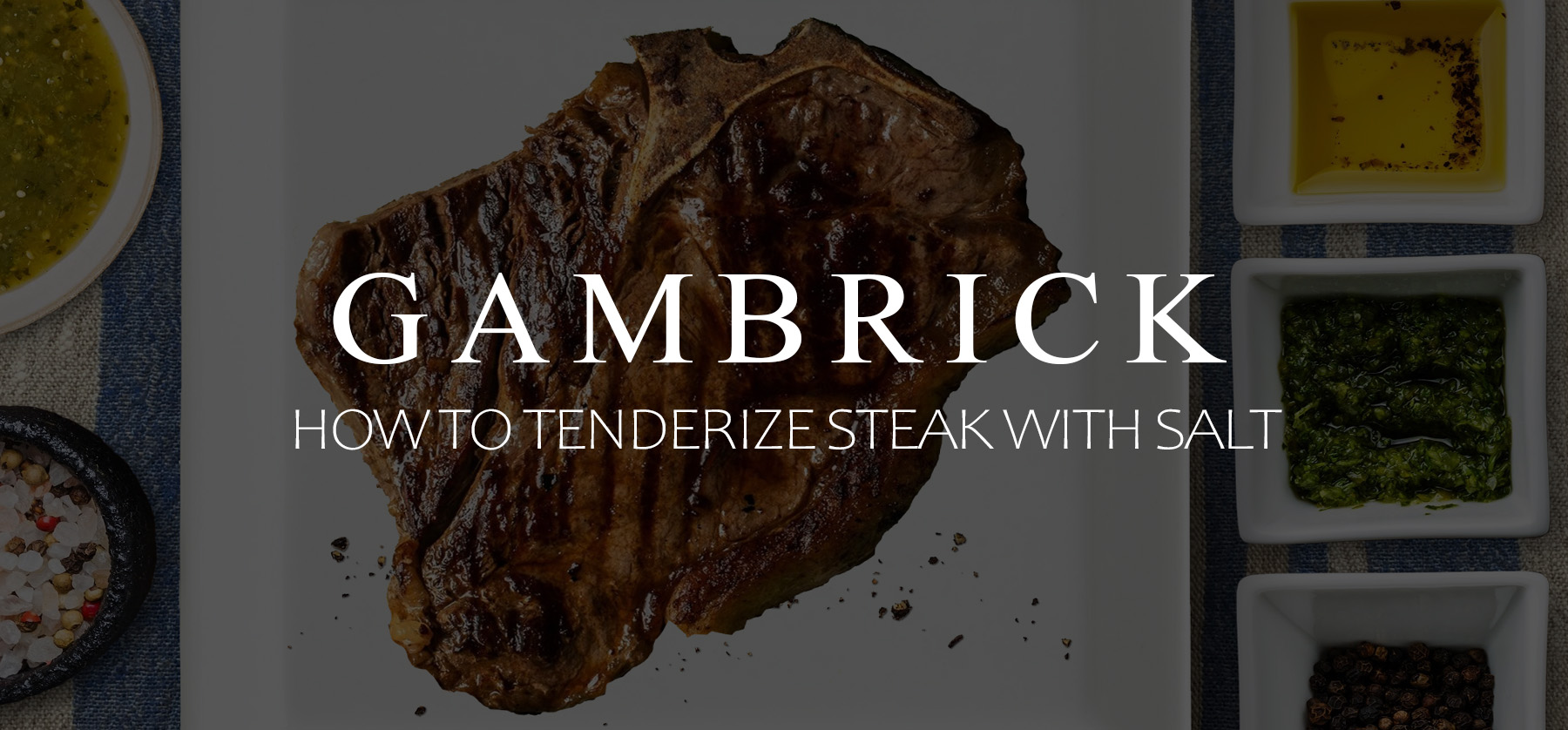How To Tenderize Steak With Salt
Salt is a great way to tenderize a tough steak before you cook. On either a cutting board or other cleanable surface, pour a bed of salt roughly the size of your steak. Place the steak on top and completely cover it with salt. Make sure to cover the meat completely including the sides. Leave the steak covered for 15 minutes. Never go longer than 20 minutes. Remove the steak from the salt and rinse it thoroughly. Finally, pat it dry with a paper towel and get ready to cook. After a salt bath the meat will be more tender and easier to chew.
Don’t use regular table salt to tenderize a steak. It contains iodine which can give the meat a strange chemical flavor. It’s also too fine which makes it hard to wash off later. Table salt usually results in a weird tasting over salted steak. Use coarse kosher or sea salt instead.
Use salt along with a spiked meat mallet tenderize a steak even more. Pound both sides of the steak evenly. As you pound the meat small dimples will be created by the mallet’s spikes. These dimples allow salt and brine to penetrate deeper into the steak.
Tenderizing steak with salt is easy, here’s how:
- Completely sprinkle coarse salt over both sides of the steak.
- Salting a steak works better if you pound it with a spiked meat mallet first.
- Allow the steak to rest for 15 minutes.
- Rinse off the excess salt.
- Dry the steak with a clean paper towel.
- Season and cook.
Salt draws out the steak’s natural juices which then dissolve the salt creating a brine solution. The brine then absorbs into the meat, adding moisture while tenderizing.
In addition to tenderizing the meat, salting also gives it great flavor. Just remember not to over-salt when you season the meat.
When you tenderize steak with salt it will turn a little brown in color. Don’t be worried, this is normal and harmless.
What Makes Steak Tough & Chewy?
Steaks are actually muscles cut from a cow.
Muscles that get lots of exercise are denser with less fat marbling. This makes them tougher and harder to chew. But areas of a cow that don’t get used as much are softer with more marbling. This makes the meat more tender.
- Muscles at the top of the animal, around the backbone and ribs, don’t get much exercise so the meat is soft and tender with more marbling. These are your high-end steak cuts like prime rib, tenderloin, porterhouse, etc. Unfortunately, these areas tend to be smaller which is why an entire cow only provides a few prime steaks. This increases the price of the meat.
- Working parts of a cow, like the legs, neck and lower muscles, get more exercise so the meat is tough and sinewy with more strips of fat and less marbling. There are more tough cuts on a cow than tender cuts so the price is much lower. These include Chuck, Brisket, Skirt, and Flank. Meat from these areas are more affordable.
When it comes to steak it’s generally the case that the more expensive a steak is the more tender it will be. A Rib Eye or Filet is more expensive and a lot more tender than a Skirt or Flank Steak. But it doesn’t necessarily taste that much better. Some tougher cuts of steak have a fantastic beef flavor, but are a little chewy.
Luckily a tough cut of steak can be made a lot more tender with salt.
Muscle is made up of long strings of connective tissue called fibers. Surrounding the muscle fibers are a thin gelatinous substance called collagen and fat.
Tenderizing beef with salt breaks down and weakens these fibers and dissolves collagen and fat into brine which makes the meat softer and more tender.
Why Tenderize Steak With Salt?
Salting a steak is a form of “dry brining”. Salt draws water out of the meat and dissolves fats and collagen to form a brine. The dissolved salt, fats and collagen form a brine that then reabsorbs back into the meat.
When the salt brine is absorbed into the meat, it breaks down tough protein cells which helps tenderize the meat.
Combine salt brining with a spiked meat tenderizer for even better results.
Pounding steak with a spiked mallet creates small dimples on the surface of the steak. These dimples allow salt brine to penetrate deeper into the steak which softens the meat even more. This is why I always pound my meat before salting. It makes the salt brine much more effective.
How To Prepare A Steak For Tenderizing With Salt
Make sure the steak is clean and at room temperature. Don’t try to tenderize a steak with salt if it’s frozen. If you buy a steak at the grocery store, remove it from the package, rinse it off and pat it dry. Then start salting.
For even better results with salt brining steak, pound it first with a spiked mallet. The spikes leave indentations that allow salt brine to penetrate deeper into the meat.
What Type Of Salt Do You Use To Tenderize Steak?
The best salt to use for tenderizing steak is kosher or other coarse salts. Do not use regular iodized table salt. It contains iodine which can give the meat a strange chemical flavor. It’s also too fine which makes it hard to wash off later.
Table salt usually results in a weird tasting over salted steak.
The color of the salt doesn’t matter but I like Pink Himalayan Sea Salt.
Another Way To Tenderize Steak With Salt
A second way to tenderize steak with salt is with a lighter sprinkle and not a full on salt bath.
- Place your steak on cutting board and generously sprinkle coarse salt on both sides and the edges. But don’t completely cover the steak.
- Use about 1 teaspoon of salt per side on an 8-10 oz. steak.
- Gently massage the salt into the meat,. This helps the salt stay on the meat.
- Let the steak rest for 1-2 hours in the refrigerator.
- Rinse the steak thoroughly and pat dry with a paper towel.Season the steak and start cooking.
Pro Tip: It’s very easy to over salt a steak that you’ve tenderized with salt. If you don’t thoroughly rinse all the salt off before you season the meat it could taste very salty. Keep this in mind when rinsing and seasoning your steak.
Tenderize Steak With A Mallet Before You Add Salt
Pounding steak with a spiked meat tenderizing mallet makes a salt bath more effective. The dimples on a spiked mallet make small holes in the meat’s surface. These holes allow the salt brine to penetrate deeper into the meat which makes it more tender and juicy.
Pound the beef evenly on both sides to break up tough muscle fibers and connective tissue.
Here’s a breakdown of the process:
- Lightly wrap the meat in waxed paper or plastic and place it on a cutting board. This will help prevent cross contamination.
- Use a good quality dish-washer-safe cutting board that’s well sanitized.
- Using a spiked meat mallet, hit the meat hard enough to form dimples but not hard enough to shrink it.
- Pound both sides evenly. As you hit the beef you’ll notice dimples form on the surface. This means you’re breaking down and penetrating into the muscle fibers.
- If you hit steak too hard it’ll start to get slimmer. You don’t want this to happen because meat can get tougher when it’s compressed.
- Remove meat from the wrap and rinse it off.
- Place it into the salt bath for 15 minutes.
- Remove the steak and rinse it thoroughly.
- Season and cook.
Once the meat is tenderized, season it and begin cooking.
Rinse all the salt away before you season the steak or it may taste salty.
Be careful when you season the steak. if you didn’t rinse all the salt off you could make it taste salty by adding more salt.
Can You Over Salt Brine A Steak?
Yes, never leave a steak in a salt bath for over 15 minutes. Salt brining beef for more than 20 minutes will over tenderize the steak and could eventually make it mushy. You’ll still be able to use it for steak tacos, fajitas, sandwiches or a stew, but it won’t be good as a traditional steak dinner.
Does Salt Really Tenderize Steak?
Yes, salting the exterior of a steak is a great way to tenderize the meat. It draws out moisture and mixes with fats and collagen to create a brine that is then re-absorbed back into the steak. During this process, lean muscle proteins are broken down and made juicier, more flavorful and tender.
How Much Salt Do You Put On A Steak To Tenderize It?
There are two ways to tenderize a steak with salt. Generously season both sides of the steak with about 1 teaspoon of kosher salt per side of an 8-10 ounce steak. Let the meat rest in a refrigerator for 1-2 hours. Thoroughly rinse and pat dry the meat, season and cook.
The second method is to place the steak in a bowl and completely cover it with salt. First, cover the bottom of the bowl in salt. Then place your steak onto the salt bed and completely cover the steak on all sides and its top in salt. Let the meat rest in or out of a refrigerator for just 15 minutes. Do not let the meat stay covered for more than 20 minutes or it will start to get mushy. Thoroughly rinse and pat dry the meat, season and cook.
To salt steak, use only kosher or other coarse salt instead of regular iodized table salt.
Does Salting Steak Make It Tough?
Salting steak for a short period of time does not make it tough, it makes it more tender. Generously season both sides of the steak with about 1 teaspoon of kosher salt per side of an 8-10 ounce steak. Let the meat rest in a refrigerator for 1-2 hours. Thoroughly rinse and pat dry the meat, season and cook.
During the salting process, salt draws out moisture from the meat and mixes with collagen and fats to create a brine. The brine then reabsorbs back into the steak which makes it juicier, flavorful and tender.
However, if you leave steak in salt for long periods of time, it will eventually start to dry out and get tough.
What Is The Best Natural Tenderizer For Steak?
The best natural tenderizer for steak is salt. Use kosher or other coarse salt instead of table salt. Generously season both sides of the steak with about 1 teaspoon of kosher salt per side of an 8-10 ounce steak. Let the meat rest in a refrigerator for 1-2 hours. Thoroughly rinse and pat dry the meat, season and cook.
During the salting process, salt draws out moisture from the meat and mixes with collagen and fats to create a brine. The brine then reabsorbs back into the steak which makes it juicier, flavorful and tender.
Don’t use regular table salt to tenderize a steak. It contains iodine which can give the meat a strange chemical flavor. It’s also too fine which makes it hard to wash off later. Table salt usually results in a weird tasting over salted steak. Use all natural coarse kosher or sea salt instead. I like Pink Himalayan.
Summary: How To Tenderize Steak With Salt
Salt is a great way to tenderize a tough steak before you cook. On either a cutting board or other cleanable surface, pour a bed of salt roughly the size of your steak. Place the steak on top and completely cover it with salt. Make sure to cover the meat completely including the sides. Leave the steak covered for 15 minutes. Never go longer than 20 minutes. Remove the steak from the salt and rinse it thoroughly. Finally, pat it dry with a paper towel and get ready to cook. After a salt bath the meat will be more tender and easier to chew.
Don’t use regular table salt to tenderize a steak. It contains iodine which can give the meat a strange chemical flavor. It’s also too fine which makes it hard to wash off later. Table salt usually results in a weird tasting over salted steak. Use coarse kosher or sea salt instead.
Use salt along with a spiked meat mallet tenderize a steak even more. Pound both sides of the steak evenly. As you pound the meat small dimples will be created by the mallet’s spikes. These dimples allow salt and brine to penetrate deeper into the steak.
Tenderizing steak with salt is easy, here’s how:
- Completely sprinkle coarse salt over both sides of the steak.
- Salting a steak works better if you pound it with a spiked meat mallet first.
- Allow the steak to rest for 15 minutes.
- Rinse off the excess salt.
- Dry the steak with a clean paper towel.
- Season and cook.
Salt draws out the steak’s natural juices which then dissolve the salt creating a brine solution. The brine then absorbs into the meat, adding moisture while tenderizing.
In addition to tenderizing the meat, salting also gives it great flavor. Just remember not to over-salt when you season the meat.
When you tenderize steak with salt it will turn a little brown in color. Don’t be worried, this is normal and harmless.
If you have any questions about tenderizing steak, email any time.





















